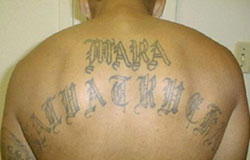Immigration Law
In 1996, Congress passed the Illegal Immigration Reform and Immigrant Responsibility Act (IIRIRA). The new law increased border patrols, amended the policy toward illegal immigrants, and more importantly in the case concerning MS-13; it radically altered how criminal cases and deportation of legal immigrants were handled.
Firstly, under previous legislation, legal immigrants were only faced with immediate deportation for crimes that carried five or more years of jail time or fines over $200,000. These limits characterized crimes as being aggravated felonies.
Under IIRIRA Congress redefined aggravated felony to include a broader set of crimes that have prison sentences as low as one year and fines above $100,000. However, since the one year limit does not take into account probation and actual time served, it was possible to fall under IIRIRA’s deportation umbrella without spending a single day in jail. Effective April 1, 1997, crimes such as shoplifting, drug possession, or even speeding could land a legal immigrant in a removal hearing. 1
Secondly, IIRIRA removed the provision of “suspension of deportation.” This allowed residence for immigrants who have good standing as citizens in the U.S. for at least seven years and whose deportation would cause extreme hardship to another U.S. citizen. The new term “cancellation of deportation” applied only to green card holders, withholding this safety net for the majority of immigrants.
Finally, IIRIRA had also made it difficult for immigrants to get judicial review on INS rulings. INS officials can unilaterally determine the fate of a legal immigrant who is either re-entering the US at a port of entry or cannot demonstrate a continuous stay in the US for the past two years. 2
Deportation to Central America
With little or no judicial oversight, the new immigration law provided law enforcement with an easier alternative to deal with the foreign dominated gangs such as MS-13. “The Immigration and Customs Enforcement Division (ICE) of the Department of Homeland Security (DHS) confirms that approximately 70% of foreign gang members who are apprehended cannot be charged with a crime and are therefore deported on immigration violations, rather than on criminal grounds.” 3 Since 1993, more than 4,000 immigrants, legal and illegal, and often teenagers, have been deported to El Salvador 4.
Despite being immigrants to the United States, these young gang members often have very little experience living in their birth countries. The people they find most in common with are their fellow deportees, who are often fellow gang members from across the United States. Together, they formed a branch syndicate of their mother gangs; the MS-13 Salvadoran branch calls themselves the "Marineros."
In a country that has only recently ended a bloody civil war, these transplanted gangsters introduced the violence learned in the streets of United States, as well as the organization and rivalries of their own cliques and gangs. With a small and overwhelmed police force, El Salvador is no match for this new breed of criminals. The infantile Civilian National Defense with small pistols and nightsticks are matched up against gang members with M-16s. As much as 60% of the Salvadoran prisons are filled with deportees or exiles from the United States. Around 1,800 inmates pledge to the MS-13. These prisons are “like a college” for the MS-13, where prisoners and MS-13 members from all across the United States can network. 5 With high unemployment, few amusements, and a large population living in poverty, El Salvador is ripe with eager recruits. One gang member, Francisco Campos claimed to have recruited over 300 initiates within a month from San Salvador. From the capital to the villages, graffiti lines the walls including one saying: “We control the nation” – in English. 6
Police have noted that MS-13 members in El Salvador are cooperating with their brothers in United States to commit more sophisticated crimes, including human smuggling, drug trafficking, arms dealing, and racketeering. Gang leaders facing convictions in United States also take advantage of the support structure of their Salvadoran branches to lay low. This increased interaction has led to the second half of the cycle where deportees from the U.S. begin to smuggle themselves back across the border, bringing with them other gang members toughened by the lawlessness in El Salvador. Today, when MS-13 members are deported, they have a network at their disposal to return to the United States. Some gang members have gone through this cycle of deportation and reentry several times. 7
Back in the United States
In the Washington D.C. area, Marineros who have snuck through the border have settled to form an offshoot of the larger gang, calling themselves the Sailors. These are usually men from El Salvador, some of whom are civil war veterans, in contrast with the teenage boys recruited by the homegrown MS-13 cliques. “Today, the Sailors are the ‘most violent and influential’ branch in southern Maryland. ‘They don't directly control the cliques, but what they say goes.’” 8
Recognizing the transnational gang problem, the FBI has established the MS-13 National Gang Task Force and the National Gang Intelligence Center to facilitate communication and coordination with ICE and local law enforcement. In addition, the FBI also has begun working with Central American governments, giving them notices of deportations of know criminals. The international collaboration also includes apprehending exiled criminals who have fled across borders for refuge. 9
